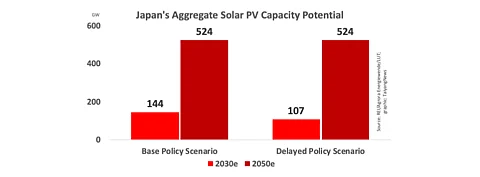

A solely renewables based zero-carbon energy supply is possible for Japan, and affordable too enabling the country to achieve climate neutrality by 2050, as aimed by the government in October 2020 (see Japan Pledges Carbon Neutral Target By 2050).
Solar PV is expected to play a significant role in this almost reaching the technical capacity limit of 524 GW, according to an assessment by Japan's Renewable Energy Institute, Germany's Agora Energiewende & Finland's LUT University in their new report titled 'Renewable pathways to climate-neutral Japan: reaching zero emissions by 2050 in the energy system'.
The study provides a 3-step roadmap for renewables deployment with LUT University performing a 'first-of-its kind' modeling of the Japanese energy system across sectors and regions, and a one-hour time resolution. It allowed the researchers to precisely capture all the flexibility requirements and technical options to facilitate the integration of very high shares of variable renewables in Japan.
The 3-step roadmap envisions 45% reduction in Japan's GHG emissions by 2030, relative to 2010 in a 1st step; emissions to decline by at least 90% by 2045 in a 2nd step; and green synthetic fuels eliminate residual emissions, mostly from high-temperature heat generation in the industry.
It covers 88% of all current GHG emissions, including energy conversion, transport, buildings, and industry.
Solar PV growth
According to the report, growing electrification in all sectors will push up electricity consumption in Japan between 2020 and 2030; and to cover this demand the installed capacity of solar PV is anticipated to increase dramatically in Japan. Spurred by its declining costs, the authors anticipate to reach average solar power generation cost of JPY 3.9 per kWh ($35 per MWh) in 2050. Thanks to these factors, solar PV is forecast to become the main power generation source in Japan in 2050.
Report writers have modeled that by 2030, installed PV capacity will more than double to 144 GW, increasing from 61 GW installed at the end of 2020, under a Base Policy Scenario (BPS) assuming favorable policies for massive and early introduction of renewables in all sectors. Authors estimate the required annual net newly installed capacity for solar PV will be 8.4 GW between 2021 and 2030, in the BPS.
Prosumers will play a significant role in this growth of solar PV in Japan, growing from 23 GW of installed capacity in 2020 to more than doubling to 70 GW in 10 years by 2030.
In a Delayed Policy Scenario (DPS)—that factors delayed energy transition in all the energy sectors—aggregate PV capacity is expected to grow to 107 GW by 2030, but still reaching a maximum of 524 GW by 2050.
In comparison, onshore wind should grow to 18 GW by 2030, and 88 GW by 2050 as against 4 GW at the end of 2020. With no offshore wind to start with at the end of 2020, this power generation source is expected to reach 7 GW in 2030, scaling up to 63 GW in 2050.
Increase renewables share
However for the country to achieve net zero emissions at reasonable costs, based on renewables deployment and electrification, Japan would need to fix an interim target of at least 40% renewables share in total power generation by 2030, to transition to a 100% scenario in 2050.
Coal
According to the report, Japan should be aiming for an accelerated coal phase-out in power generation by 2030, while increasing its renewables target in its total energy mix to 40% by 2030, which would provide the 'lion's share of emissions reductions'. In the event of delay in coal phase out beyond 2030 it is likely to cost Japan high GHG emissions while making the transition more difficult as deployment of renewables will get pushed back by 5 years, as per the report. Currently, coal comprises a 25.4% share in the total energy mix of Japan, accounting for about 1/3rd of total electricity supply, while the share of renewables reached 18% in 2019.
"In such a delayed scenario, only half as much PV and onshore wind capacities would be built in 2021-2030, which would need to be compensated for in the years after 2030 when direct and indirect electrification would intensify," caution the writers.
Going forward, the report writers argue that government action 'starting now' will determine how Japan would achieve its climate neutrality goal by 2050. Their eyes are now glued to the upcoming discussions on the 6th Strategic Energy Plan that will set the course of action for the land of the rising sun.
Among other major findings of the report, the writers claim nuclear power is not necessary for Japan to achieve its long term decarbonization target at lower costs thanks to the growth of renewables.
The report is available for free download on REI's website.
